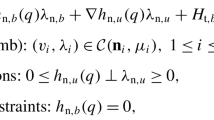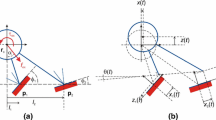Abstract
In this paper, we study the problem of predicting the quasistatic planar motion of a passive rigid body in frictional contact with a set of active rigid bodies. The active bodies can be thought of as the links of a mechanism or robot manipulator whose positions can be actively controlled by actuators. The passive body can be viewed as a “grasped” object, which moves only in response to contact forces and other external forces such as those due to gravity. We formulate this problem as a certain uncoupled complementarity problem, and show that it belongs to the class of NP-complete problems. Finally, numerical results of our proposed linear programming-based solution algorithm for this class of problems are presented and compared to the only other currently available solution algorithm.
Similar content being viewed by others
References
K.P. Bennett and O.L. Mangasarian, “Bilinear separation of two sets in n-space,” Computational Optimization and Applications, vol. 2, pp. 207–228, 1993.
R.W. Cottle, J.S. Pang, and R.E. Stone, The Linear Complementarity Problem, Academic Press: Boston, 1992.
P.E. Gill, W. Murray, and M.H. Wright, Numerical Linear Algebra and Optimization, vol. 1, Addison-Wesley Publishing Company: Redwood City, 1991.
R. Horst and H. Tuy, Global Optimization: Deterministic Approaches, Springer Verlag: Berlin, 1990.
J. Kerr, An Analysis of Multifingered Hands, PhD Thesis, Stanford University, Department of Mechanical Engineering, 1984.
K.G. Murty, Linear Programming, John Wiley & Sons: New York, 1983.
W.H. Press, B.P. Flannery, S.A. Teukolsky and W.T. Vetterling, Numerical Recipes: The Art of Scientific Computing, Cambridge University Press: Cambridge, 1989.
J.K. Salisbury, Kinematic and Force Analysis of Articulated Hands, PhD Thesis, Stanford University, Department of Mechanical Engineering, May 1982, Reprinted in, Robot Hands and the Mechanics of Manipulation, MIT Press: Cambridge, Massachusetts, 1985.
J.C. Trinkle and D.C. Zeng, “Planar quasistatic motion of a lamina with uncertain contact friction,” Proceedings of Intelligent Robotic and Systems, Raleigh, NC., 1992, pp. 1642–1649.
J.C. Trinkle and D.C. Zeng, “Prediction of the quasistatic planar motion of a contacted rigid body,” IEEE Transactions on Robotics and Automation, vol. 11, pp. 229–246, 1995.
J.C. Trinkle, R.C. Ram, A.O. Farahat, and P.F. Stiller, “Dexterous manipulation planning and execution of an enveloped slippery workpiece,” in Proceedings, IEEE International Conference on Robotics and Automation, vol. 2, pp. 442–448, Dec. 1993.
Author information
Authors and Affiliations
Additional information
The research of this author was based on work supported by the National Science Foundation under grants DDM-9104078 and CCR-9213739.
The research of this author was partially supported by the National Science Foundation under grant IRI-9304734, the Texas Advanced Technology Program under grant 999903-095, and the Texas Advanced Research Program under grant 999903-078.
Rights and permissions
About this article
Cite this article
Pang, JS., Trinkle, J.C. & Lo, G. A complementarity approach to a quasistatic multi-rigid-body contact problem. Comput Optim Applic 5, 139–154 (1996). https://doi.org/10.1007/BF00249053
Received:
Revised:
Issue Date:
DOI: https://doi.org/10.1007/BF00249053




